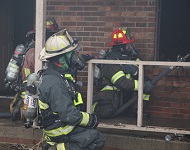
Photo by Tony Greco.
By O.J. Kolodziej
As today’s fires burn faster, it is important that our personnel are well-prepared for a rescue. We should always have the mindset that every fire to which we respond will involve a rescue. This mindset should not diminish until the building has been deemed clear.
With regards to rescue, another factor we must control is the fire. A fire will double in size every 30 to 60 seconds if it is not properly controlled; this is why it is imperative that we make the rescue a fast as possible.
Our number-one goal is life safety, but we cannot forget the fire attack even while in the middle of a rescue. If we put the fire out, 90 percent of our problems disappear.
Are we training our people for rescue properly? When we train for a vent-enter-isolate-search event, students will always have questions. The main question most likely will be, “Why was the I added to VEIS?” When teaching, the answer I tell students is: “The ‘I’ stands for ‘Isolate.’” This is our first line of defense because we are performing the VEIS technique without a hoseline.
The isolation provides protection to the victim as well as the rescuer. It will also help ensure that we do not have an uncontrolled flow path. When students understand isolation, the next lesson should ensure that they are all aware that VEIS is not only for upper floors; they can perform VEIS on all floors (and below-grade, if needed). Too often, personnel will think VEIS is only for upper floors.
RELATED: Kerrigan on VEIS: The Engine Company’s Perspective ‖ Halton on VEIS ‖ Shupert on Using VEIS Tactics
When VEIS training takes place, do personnel have a clear understanding of how to do the task? When teaching, I first like to break down each letter and then move to the drill ground to ensure that the student can do the task.
VEIS TIPS
Following are a few tips on VEIS:
- Ventilation. When we arrive on scene and we are doing our 360° size-up, identify high-target areas, which are rescue areas such as bedrooms and bathrooms. While we find the high-target area and are getting ready to vent, we must ensure that if we are on upper floors, the ladder is set at a 60° angle and that we do not use the ladder to break the window. If we use the ladder tip to break the window, we can create an uncontrolled flow path. When taking the window, use the proper tool, and ensure that you take out the whole window along with the frame, if possible. When the glass is out, read the smoke, noting its volume, velocity, density, and color. What is all that information telling us?
- Enter. Prior to entry, sweep the bottom of the window; most victims will be located on the floor and will be close to a means of egress. Once you sweep the floor, sound the floor. The reason you do not want to sound the floor first is because you could possibly hit the victim, causing him further harm. After you check the floor, do a quick scan of the room using your thermal imaging camera. Next, go into a “box shape” and check the floor for victims or holes, looking for the neutral plane; if the plane is high, then you are good. If the neutral plane is low, this represents a high hazard, and you must move quickly to do your search and find the door. Once you have entered the room, place a tool (such as a pike pole) with the point out and in the window; this will give you a marker on how to get out as well as give ground crews a “head’s up” that someone is inside that room.
- Isolate. Once you find the door, lay on the floor as flat as possible. Next, crawl out into the hall, and sweep the floor for victims. Once you sweep the hall, close the door.
- Search. Do this efficiently! Simply going around the room will not cut it. Cover every square inch of the room—under and on top of beds, under tables, and inside cribs. Do this all by hand. (Yes, the TIC is a great tool to assist you with search, but it can lie to you.) A victim could be covered by blankets or masked by debris, so ensure all searches are conducted by hand.
When the room has been completely searched, exit the room and move to your next high-target area.
VEIS is not a task that can just “happen.” To ensure that VEIS tasks are being done properly, develop a training program in your department.
O.J. Kolodziej is a lieutenant with Birmingham (AL) Fire and Rescue assigned to Station 1. He can be reached at Joseph.kolodziej@birminghamal.gov.

